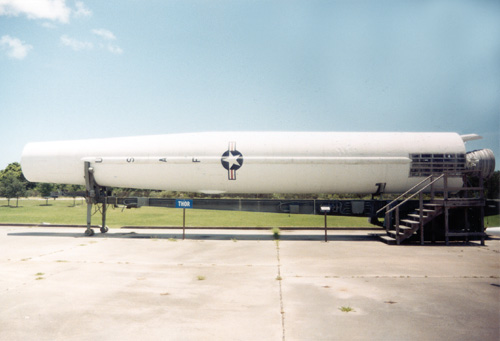
|
Douglas Aircraft Company Thor IRBM |
 |
The Thor is a single-stage Intermediate Range Ballistic Missile that was developed as a stopgap until the
Atlas was complete. The Thor was developed by the Douglas Aircraft Company (now Boeing).
Designated SM-75 (Strategic Missile-75), the Thor was America's first IRBM. It was
propelled by a single main engine, and used two smaller (1011 lb. thrust) vernier engines for roll and altitude control.
All engines were powered by LOX (Liquid Oxygen) and kerosene.
Work on the Thor started in 1955. The first missile was
delivered on October 20, 1956, and testing began. On December 20, the first attempted launch (from Complex 17
Pad B) was scrubbed since the main engine would not ignite. Another attempt was made on January 25, 1957, in which the
missile fell back on the pad and exploded. After a series of test failures, the first completely successful launch took
place on September 20, 1957. Testing continued into 1958, and the Thor was subsequently delivered to
four Royal Air Force bases in Britain then declared operational in May of 1958.
A total of 60 Thor missiles were deployed in Britain. They
remained operational until the end of 1963. Thor missiles were also used in the United States for high-altitude nuclear
testing and ASAT (anti-satellite) testing. Thor missiles were also mated to high energy upper stages to create powerful
launch platforms. In fact, the first stage of the Delta II rocket is a derivative of the Thor
IRBM.
| Thor specifications and performance |
| Length |
71.25 ft. |
Weight |
110,400 lbs. |
| Thrust |
160,000 lbs. |
Speed |
10,000 MPH |
| Ceiling |
300 miles |
Range |
1500 miles |
| Warhead |
W-49 thermonuclear (4 MT) |

